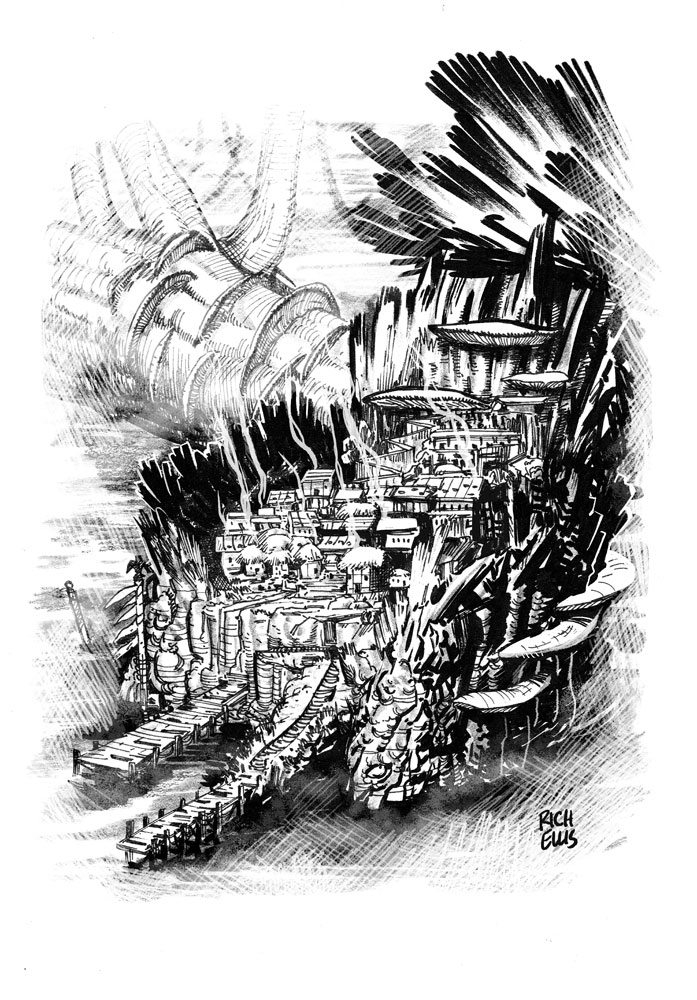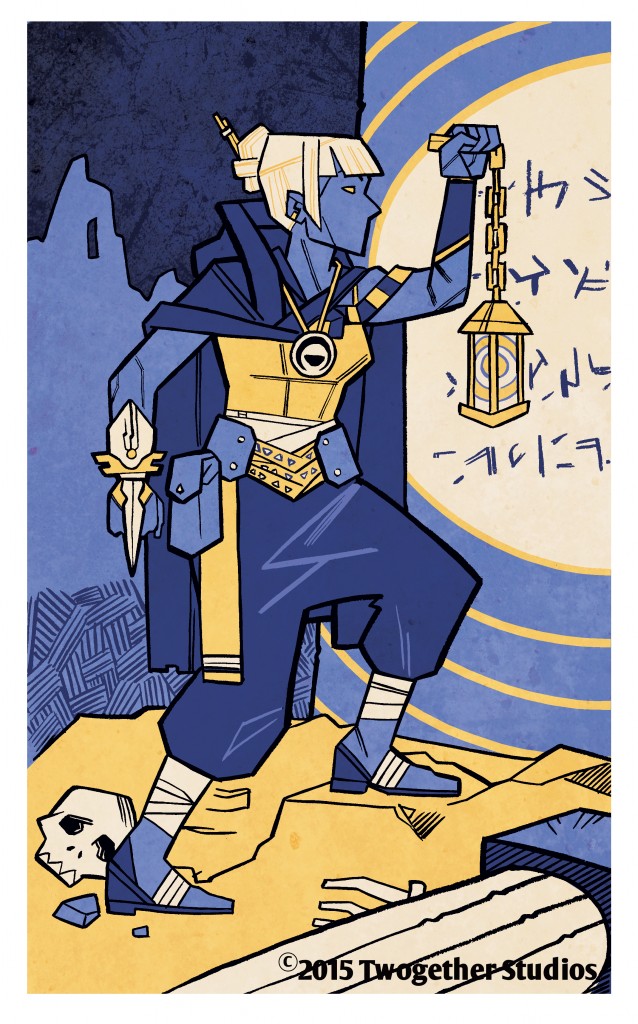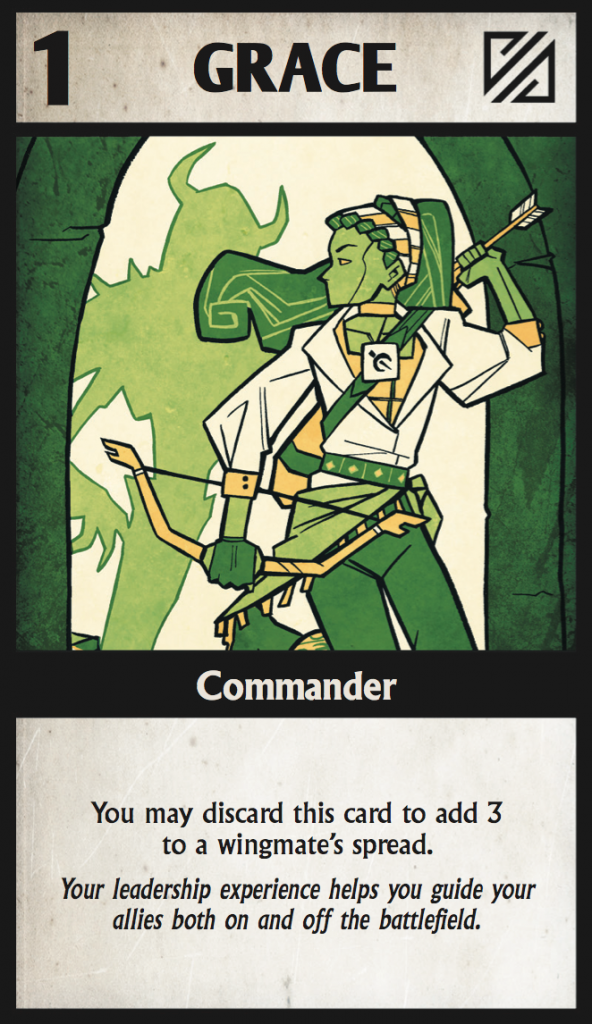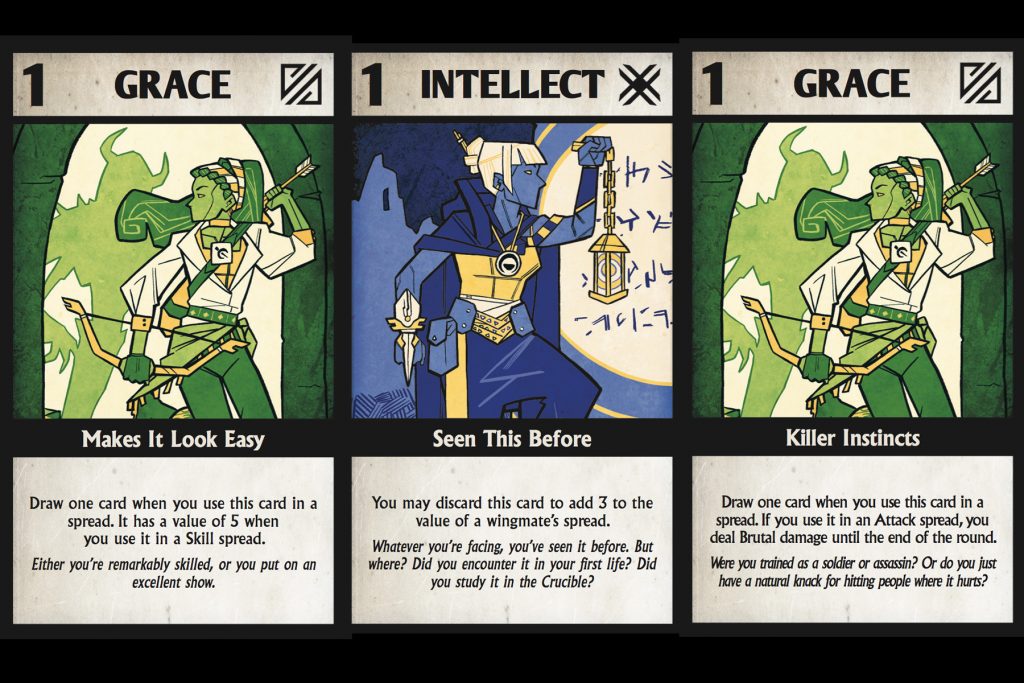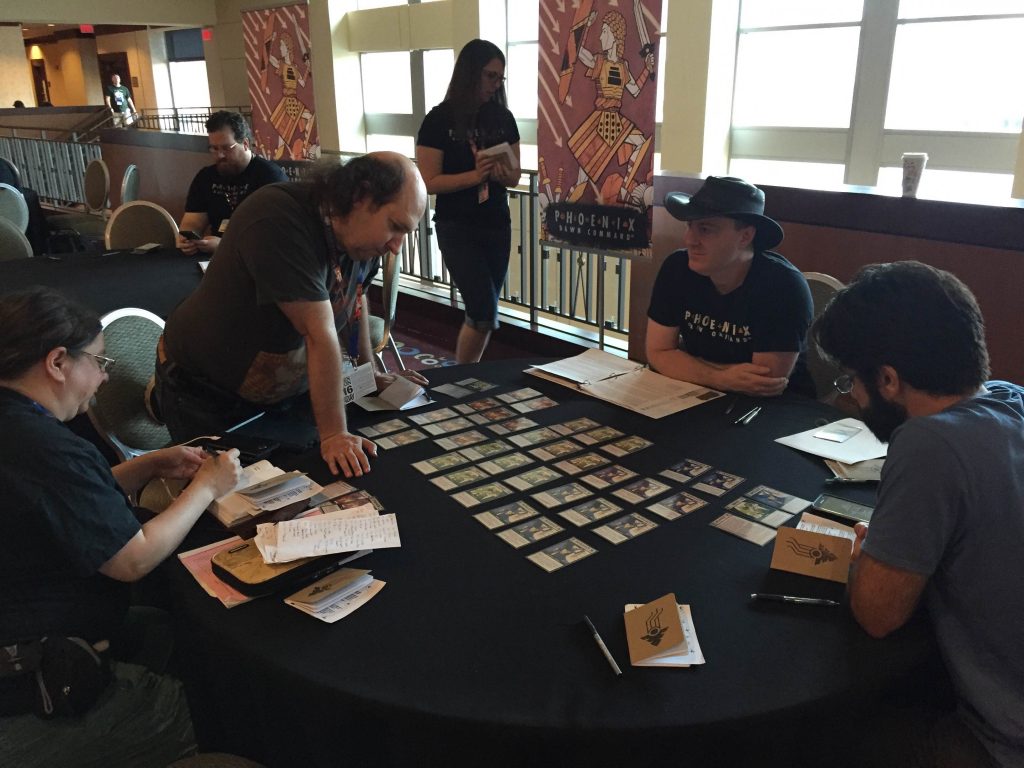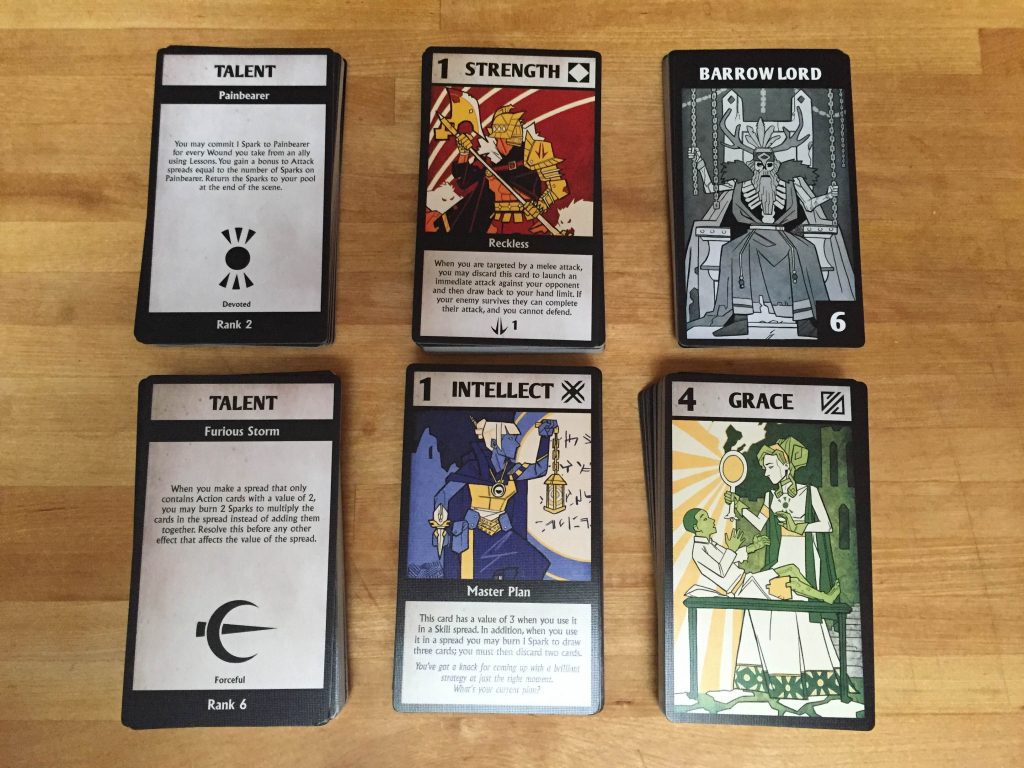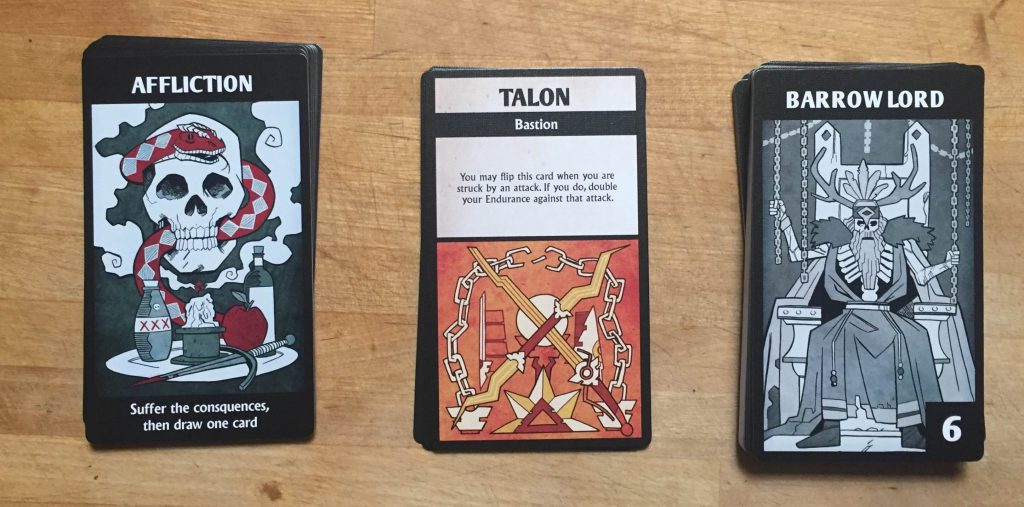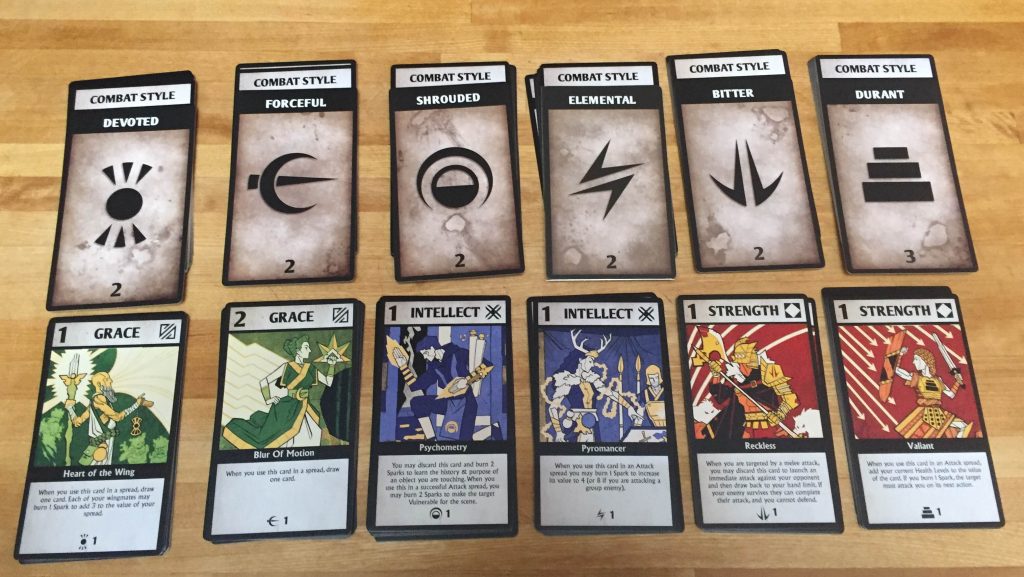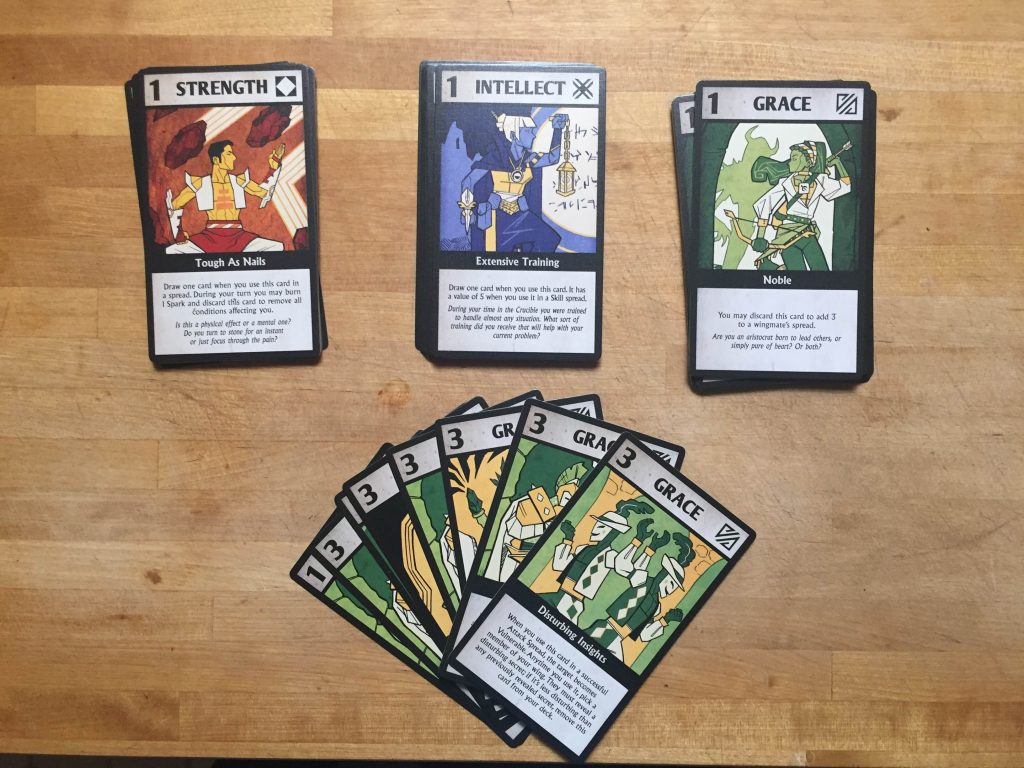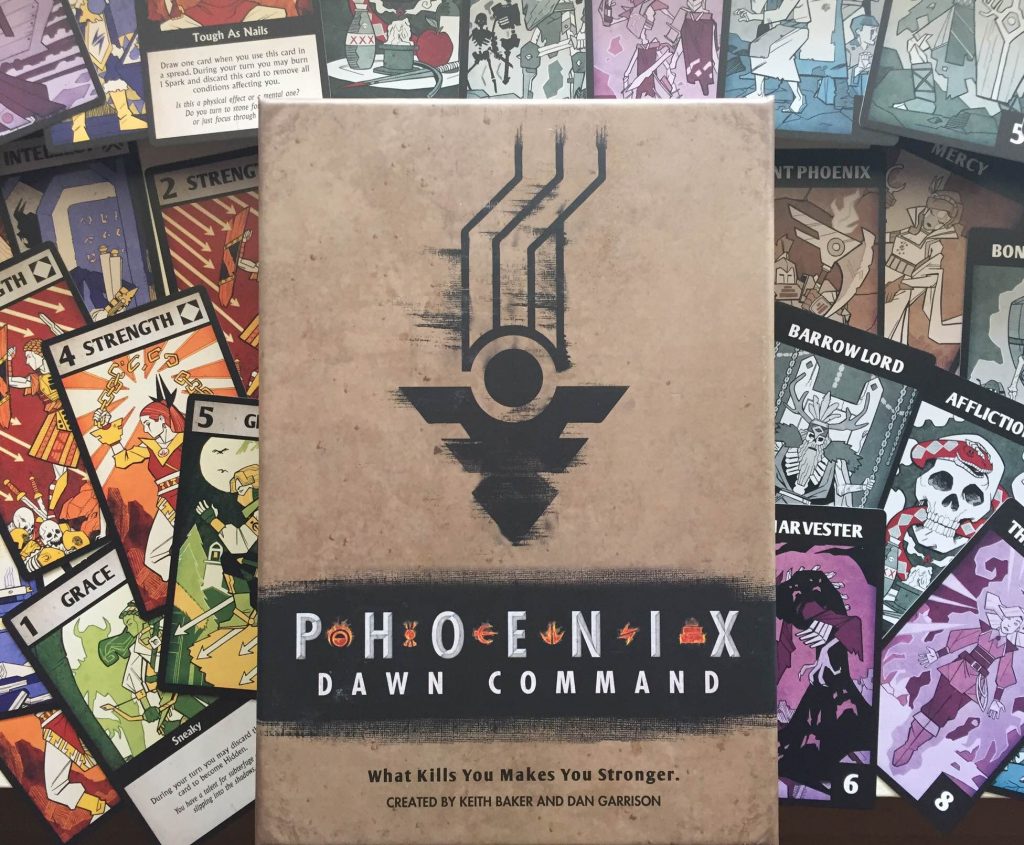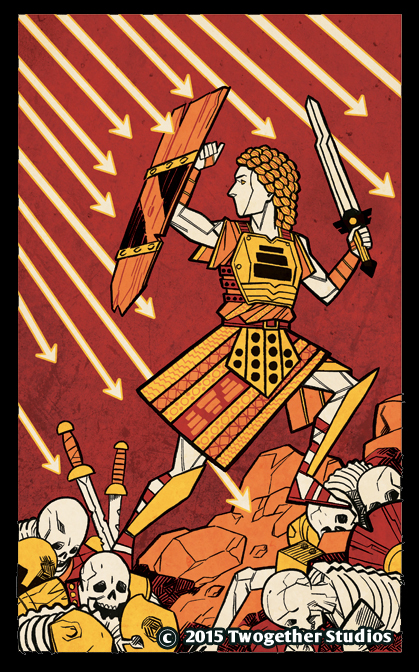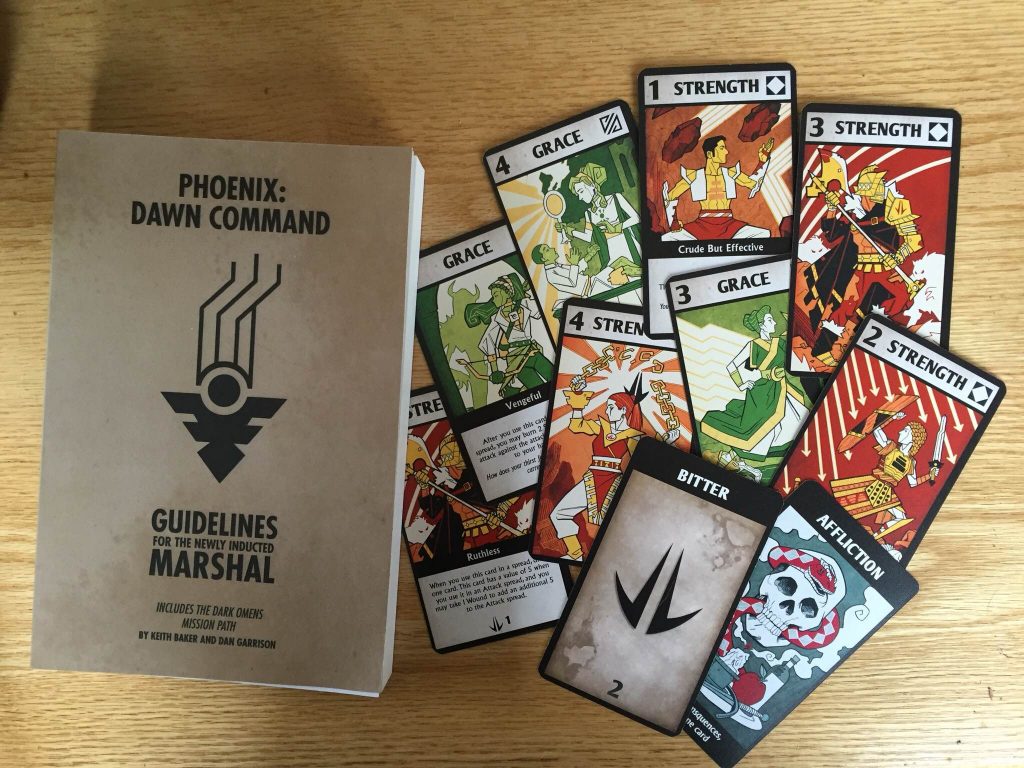Welcome to the second installment of Phoenix Friday! Every week in June I’m going to be posting material for my new RPG, Phoenix: Dawn Command. Phoenix is now available for sale, either from Amazon or directly from me through Twogetherstudios.com. If you have any questions about Phoenix, please post them in the comments below. If you’d like to see Phoenix in play, you can check out the livestream PDC game on the Saving Throw network — the final episode of Season Two will be streaming Saturday, Jun 10th at 12:30 PM Pacific Time!
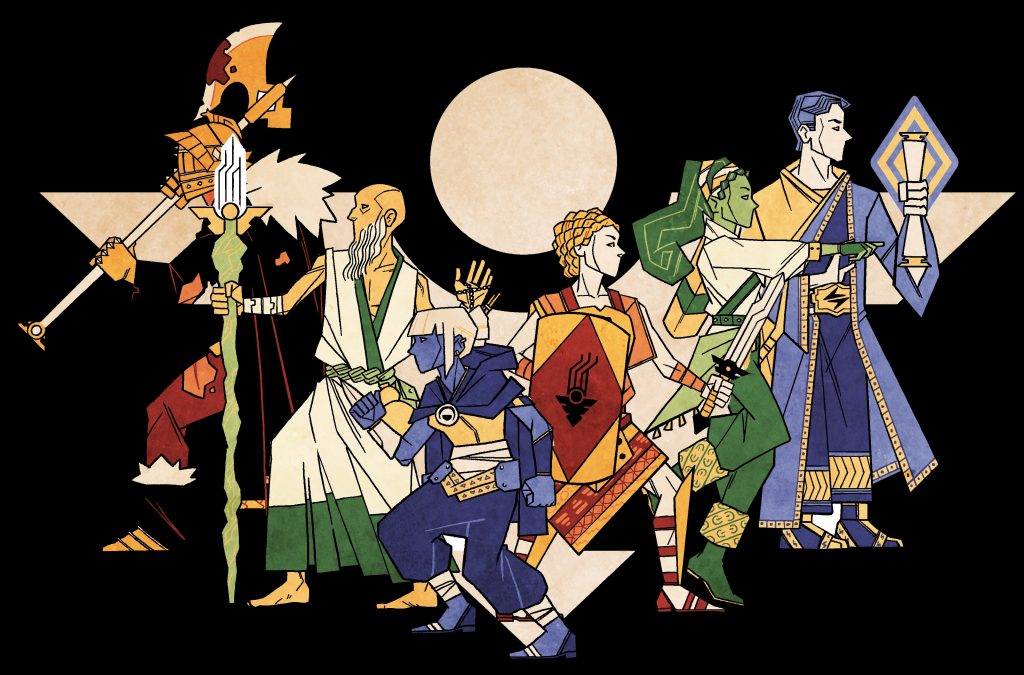
Phoenix: Dawn Command is a war story. Your world is under attack by a host of supernatural terrors. The dead prey upon the living. Ghosts howl with the wind. Skinchangers and stranger beasts lurk in the wilds. Entire cities have been lost to a chant that turns those who hear it into killers. As the game begins, we know we are at war with the Dread, but we know almost nothing about it. Why are these things happening? How are they related to one another? Can they be stopped, and if so how?
As a Phoenix, your character is someone who died and was given the chance to return to life with the power to fight the Dread. But that power didn’t come easily; you went through spiritual and physical trials to earn the right to return as a Phoenix. So when you are making a character, there are questions we want to answer.
- Who were you in your first life? How did you die, and how long were you in the Crucible before you were reborn as a Phoenix?
- What are you fighting for? What gave you the strength to overcome the trials of the Crucible?
- What do you have left in the world? Do you have relatives or descendants? The town you grew up in, or failing that, a homeland? What do you care about?
In some RPGs, these things don’t really matter. But Phoenix is a game where you may be called upon to lay down your life — more than once — for the things you care about, and it’s going to be a much more satisfying experience if you actually care about something. With that said, this is a tall order to drop on a beginning player who knows nothing about the setting. What concepts are even possible? Where could they be from?
If you want a quick start, you can download a wing of pregenerated characters from the Twogether Studios website. Meanwhile, here’s a set of backgrounds that explore some of the more exotic possibilities of the setting. As a Phoenix, you might have been a child; a former Emperor; or even a very bad dog. These ideas are intended to be inspiration — showing what’s possible within the setting. If one of your players would like to play one of these characters, that’s great. But they could also take a piece of the idea and change it. Perhaps they like the Old Soldier, but they want to have fought alongside the Phoenixes in the Civil War instead of having opposed them. Or they like the basic concept of the Ship’s Cat, but want to be Bitter instead of Forceful. That’s great! The goal of these pieces is to give you an idea of what’s possible; what you do with them is entirely up to you. And if you don’t use any of these ideas, you might want to use them as members of the Rival Wing, as described on page 145 of Guidelines for the Newly Inducted Marshal.
THE SHIP’S CAT: FORCEFUL
“What’s over there?”
To be clear: you weren’t an actual cat. But you were born on a ship. Your people — the Wynderi — are the best sailors in the known world. Your family believe that the land first rose from the water, and that some day the waters will rise and reclaim the land. As a result, they sought to spend as much time on the open water as possible, and you almost never set foot on solid land. They called you the Ship’s Cat because you were small and endlessly curious. You were always climbing in the rigging and looking for new things on the horizon, and whenever you encountered another ship you’d sneak aboard and poke around. As it turned out, your parents’ conviction that it was safe on the water was misplaced. One day you were beset by fog. A new ship closed with you, and you naturally boarded and began to poke around. You were surprised by the rotting wood and torn sails, and too late you realized that it was a ghost ship crewed by corpses. The ghostly sailors pursued you, and you tried to get to the rigging and make it back to your ship, but you weren’t quite fast enough; the moldy ropes slipped through your fingers, and you’ve blocked out the details of what happened next. But instead of dying, you found yourself in the Crucible, with the promise of endless adventures ahead. Your optimism and your curiosity carried you through the trials, and now you’re back in the world and faster than ever. You’re on a grand adventure, and you’re going to stop the Dread and save the world.
You died as a child, and while you spent what seemed like years in the Crucible, you still maintain the essential optimism, curiosity and enthusiasm that you had in your first life. You spent your life on a boat, and now you’re getting to explore the entire world! However grim and horrifying a situation is, you’re always looking at the bright side of it. You’ve never seen a swamp before! Or a hungry ghost! What’s it going to do? Why? You want to help people — you’re a hero, and that’s exciting — but you also are just thrilled to be out in the world and on an amazing adventure.
- You’ve blocked out exactly what happened when you died. You don’t actually remember if your family escaped or if they were killed by the ghost ship. Your life is full of new adventures and there’s a lot of distractions and things you have to deal with right now. Are you excited when you see Wynderi? Do you want to find out if your family are OK? Or are you intentionally trying to ignore the Wynderi to avoid thinking about your family?
- Everything is new to you. You’ve never been in a big city or a forest. You’ve never fought a werewolf. It’s all extremely exciting. You generally look for the best in everything, as reflected by the Never Gives Up suggested Trait… but at the same time, you’re not an idiot and you’re not going to try to hug a zombie. Probably.
- As a Forceful, your greatest strength is your speed and mobility. You hate to stand still, and you’re always looking for the next interesting thing. You want to be a hero, so try not to cause too much trouble for the rest of the wing with this — but what happens if you poke that thing over there?
Suggested Traits: Crude But Effective, Small & Quick, Never Gives Up, Untouchable
ADVENTURING ARCHAEOLOGIST: SHROUDED
“That belongs in a museum!”
You’re one of the Shadovar. Your people were driven from their homeland centuries ago, before the first Phoenixes formed the Empire, and today they are nomads who travel from place to place. Superstitious people accused the Shadovar of being necromancers who traffic with the spirits of the dead, and there is some truth to this; there are skilled mediums among your people. But this is simply because you choose to honor the dead, because if you preserve the memory of those who have come before you, they never truly die. For you, this principle applies to the past as a whole. You’re intrigued by the heroes of the Empire — both the Phoenixes who founded it and the humans who took it from them. You’re equally fascinated by the cultures that existed before the Empire. And most of all, you’re fascinated by the Old Kingdoms — civilizations so old that we don’t even know if their people were even human. There are a only a handful of ruins and relics of Old Kingdoms still in existence, and they are often imbued with tremendous magical power. You believe it’s possible that the Imperial Flame itself — the force that empowers all Phoenixes — could be a relic of the Old Kingdoms. You love exploring these mysteries. And the Dread is the greatest mystery of all! It began three years ago… what caused it? How are the various manifestations of the Dread related? Is there a purpose to the Dread beyond simply destruction?
You died pursuing these questions, and you refused to remain dead while this mystery threatens to destroy all that you love. You were a great scholar in your first life, and you used your time in the Crucible to hone your skills even further. If you use the suggested Traits, Seen This Before and Brilliant Deduction may reflect your experiences in your first life, but it could also tie to your extensive training in the Crucible. You may not have actually seen this before, but you read an account of it in the endless library in your Crucible; and your brilliant deductions about the Dread may be tied to your extensive research between lives.
- Your primary concern is unraveling the mystery of the Dread — and in so doing, saving the entire Empire. With that said, superstitious people have always blamed the Shadovar for trouble, and in the present day there are many who think the Shadovar are tied to the Dread. Do you want to help the Shadovar, if you can?
- Is your family still alive? The Shadovar are traveling people, so even if they are alive you have no idea where they might be right now. But are they important to you? If so, which living family member is most important to you?
- You are fascinated by history. What period of history intrigues you the most: the golden age of the Empire? The time of the first Phoenixes? The first known human civilizations — the time before the Shadovar were driven from their homeland? Or the mysterious Old Kingdoms, about which almost nothing is known?
- You died pursuing secrets. What was it you were trying to discover? Were you killed by a manifestation of the Dread — undead soldiers, a terrible curse — or did you die in a more mundane way?
- As a Phoenix you will be fighting to protect people from the manifestations of the Dread. But you want to always be looking for answers. You’re never content just to stop a threat; you want to know why it happened and how it relates to the Dread as a whole. And meanwhile, keep an eye out for other interesting connections to history!
Suggested Traits: Brilliant Deduction, Makes It Look Easy, Seen This Before, Superhuman Reflexes
OLD SOLDIER: DURANT
“I built this Empire, and I won’t let it fall.”
Two centuries ago, a civil war split the Empire. The first Phoenixes had formed the Empire by conquest and forced its people to join together. While that may have served a greater good, in time the people grew weary of being ruled by immortal overlords. Humanist forces challenged the Phoenixes, and after a long and bitter war the Phoenixes stood down, turning control of the Empire over to humanity. The first Emperor was Mikan Dolanti of the Dol Talu — your family. You were a general in the civil war, and your military expertise helped usher in the golden age of humanity. You clung to life for as long as you could, and after your death you lingered in the Crucible… until you eventually felt the suffering of your people. You fought your way through the trials and now you have returned as a Phoenix yourself. But you will never be a tyrant. In your first life you saved the Empire from a supernatural threat; as a Phoenix, you’ll do it again.
You’re from Ilona, and as far as you’re concerned it embodies all that is good in the Empire. It’s a place of fertile fields and green valleys. Its cities are havens for culture and education. Ilona is sustained by the noble houses of the Talu, and your house — the Dol Talu — is the noblest of all. Almost two hundred years have passed since your death, and while you care deeply about the Empire, the modern world may be strange to you. Consider the following…
- What was your exact position in your family? You served as a general in the war, but did you hold a high place after the war? One possibility to consider: you could actually be Mikan Dolanti, the first mortal emperor. It would be up to you to decide whether you announced that or kept it hidden; as a Phoenix, everything about your appearance (even gender) can change upon rebirth, so it wouldn’t necessarily be obvious that you were the first emperor.
- Are you an idealist who truly cares about the entire Empire? Or are you primarily concerned with protecting your family — which includes the current Emperor?
- You’ve been dead for two hundred years. Setting aside the Dread: Are you happy with the state of the modern world? Are you thrilled with everything your descendants have accomplished, or are you a curmudgeon who feels that everything was better in your day?
- You fought against the first Phoenixes after they became tyrants. You are now part of Dawn Command, but in addition to saving the Empire from the Dread, you’ll want to make sure that these new Phoenixes don’t abuse their power.
- You were a great military leader in your life. If you use the suggested Traits, this is what Noble and Commander reflect; you can give bonuses to your allies by offering strategic guidance.
Suggested Traits: Noble, Commander, Seasoned Veteran, Superhuman Strength
WARLOCK: ELEMENTAL
“Heed my words, spirits of the Dusk, and let your flames consume my enemies!”
You were born in a crumbling farm on the barren plains of Skavia. Your family was poor and struggled to survive, though in the distance you could see the great bastion city filled with the rich and powerful. When you were young, a mysterious masked figure stepped out of the shadows and told you that it could change your family’s lot and give them wealth and comfort… but you would have to perform a service in the future, with no questions asked. You agreed, and the very next day a messenger arrived. Your mother, it turned out, was heir to a fortune; you moved to the Bastion city and lived there in comfort. As you grew older you learned about the Fallen Folk, the enigmatic spirits that lingered in the shadows of your homeland. In the past, warlocks gained great power by bargaining with the Fallen. But the first Phoenixes banished the Fallen Folk when they established the Empire. By all accounts, the Fallen were just a myth, and any interaction with them forbidden. Needless to say, you were fascinated. You studied the legends and learned the basics of Duskcraft. Most of the spells you found no longer worked, as the Fallen were banished and bound in Dusk, but the potential was intriguing.
When the Dread began, you were fascinated and concerned. Before you could delve too deeply, your masked benefactor returned. It told you that it was time for you to make good on your promise. You were to leap to your death from the top of a high tower. But the Fallen Prince promised that you would not die; you would have the chance to be reborn, imbued with great power. You could use that power to fight the Dread, and to save the world… but in the process, you must help the Fallen Folk return to the Daylit World. Most Fallen aren’t evil, or so your benefactor says; they wish to be free from their prison, and to help your people once again. Your patron promised to protect your family from the Dread if you honored your arrangement; and it pledged to destroy both you and your family should you refuse. It was your duty to die, and so you did.
As an Elemental Phoenix, your powers are tied to your studies of Duskcraft. You learned about the art of fireshaping in your mortal life, but it is only as a Phoenix that the flames began answering your call. Your astonishing luck reflects minor Fallen helping you when you are in need, and your Charming trait reflects the beguiling power of the Fallen. All this power is a great gift that can help you protect those in need. But will you honor your pledge? As you fight the Dread, will you also seek to restore the Fallen and bring them back to the Daylit World?
- Your bargain with the Fallen gave you the power you need to try to save your world. But how do you feel about it? Are you reluctantly going along with this because it’s what you need to do to protect your family? Are you excited about the idea of bringing back the Fallen Folk because of the power they could give you… do you hope to save the Empire so that you can rule it? Or are you hoping to find a way to renege on the deal and banish the Fallen you’ve been bargaining with?
- What do you know about your Fallen patron? What does it look like? Sound like? Is this reflected in your Elemental powers at all? Are the flames you conjure normal flames, or are they an unusual color? Are they flames at all, or are you actually conjuring lesser Fallen spirits that attack your foes and then vanish? Is your patron a spirit known in popular stories, or has it hidden its identity from you?
- Your Fallen patron is protecting your family, and has promised to destroy them if you betray the Fallen. How big is your family? Who’s your favorite relative, and why?
- Skavi warlocks traditionally wore half-masks covering their lower faces. Do you wear such a mask? If so, what’s the design?
Suggested Traits: Astonishing Luck, Charming, Master Plan, Warlock
BAD DOG: BITTER
“I’m going to chew you up and spit you out.”
Once upon a time, you were a good dog. You lived in the swampy Fens with a big family and you loved them very much. Then one day bad things came out of the water. They smelled rotten and sour, and though you bit them and fought them they crushed you and killed the people you loved. As you died you were consumed with anguish and loss… and filled with hatred for the things that killed your people. And somehow, that hatred carried you into the Crucible. Somehow you knew that if you fought long enough and hard enough you could return with the power to destroy the things that hurt your family. Finally you made your way through the big fire and into the world. Along the way you’ve learned many things. You’ve learned how to speak as people speak. You’ve learned that you have a new pack, or “wing” as they call it, that will help you take revenge. You aren’t going back to fight the specific things that killed your family — not yet — but you will hunt down these bad things wherever they appear and you will make them pay.
You’re a dog who has somehow returned as a Phoenix, something that’s never happened before. The Fens have stories of remarkable bond beasts, and perhaps such a creature was in your lineage. Nonetheless, here you are. Your intelligence has been enhanced in the process of becoming a Phoenix, and you are as smart as any human; you also have the power of speech. Your exact appearance is up to you — you could resemble a domestic hound, or you could be a enormous wolf with coal-black fur and burning eyes — but you are huge, strong, and you have a collar made from Pyrean steel; this is your talon, and marks you as a Phoenix. Your appearance is largely defined by the way you see yourself, and when you die and are reborn you could chose to be reborn in a humanoid form — whether as a werewolf-like hybrid, or in a purely human form. For now, you don’t have hands… but you don’t need weapons to fight, and your strength is sufficient to overwhelm most enemies.
- The wing is your pack. Is it important to you to be the alpha? If not, you may want to pick a member of the wing who takes the place of your lost family for you… whatever else happens, you are fighting to protect that character.
- You have intelligence on par with a human, but you’re not human. Many aspects of Imperial civilization make no sense to you, and you may interpret the actions of strangers in ways that fit the logic of a dog.
- Do you have the excited enthusiasm of a happy dog? Or are you entirely consumed by your quest for revenge on the Dread?
- Do you want to be human (which could eventually lead to assuming a human form upon rebirth)? Or do you consider the canine form and life to be superior to that of humanity?
Suggested Traits: Hunter, Vengeful, Terrifying, Too Big To Fail
GODSPEAKER: DEVOTED
“Let the Merciful Mother ease your pain.”
You were born into the Myr Talu, one of the noble families of Empire — though admittedly, you’re one of the noble families of the Fens, so your people are princes of the backwater swamp. Nonetheless, you were born into wealth and luxury, and you lived as hedonistic a life as was possible in the Fens. You had a lot of good times. And then something unexpected happened. You were having a mushroom party with your friends — there’s a lot of mushrooms in the Fens — when a pack of twisted beasts came crawling out of the water. You’re not sure what came over you — something in the mushrooms, perhaps? — but you ordered your friends to run and charged the beasts yourself. You were torn apart, but you bought enough time for the others to reach the boat and escape. And instead of just dying, you found yourself in the Crucible… and you weren’t alone. Your ancestors founded the Myr Talu using the power of their House Gods — mighty spirits that bound themselves to your bloodline. The House Gods were banished to the Dusk in the first days of the Empire… but now you found yourself face to face with the gods of your people, and they told you that you have a destiny to fulfil. The Dread threatens to wipe out the Myr Talu and all the people of the Empire. They will not allow that to happen, and since they cannot return to the Daylit World, you must be their hand.
You’re not the smartest person in the room. But your gods can offer your guidance, and if you use the suggested Traits, this is what Extensive Training and Smartest Person In The Room represent; when you need to do something beyond your personal talents, you can draw on the Myr gods for inspiration. Beyond this, you can channel their power to inspire others; this is reflected by your Inspiring trait and by the Core Devoted Lesson that allows you to add your cards to the spreads of your allies. When you use this ability, call on one of your gods… “Merciful Mother, give my friend the strength she needs to survive this.” Existing Myr Gods include Myr, the Bringer of Fortune, chief goddess and general source of prosperity and wisdom; Taeloch, the Serpent in the Water, the aggressive bringer of justice; and Lassia, the Merciful Mother; but you can expand this pantheon if you have an idea for a particular god that can expand the pantheon. At the moment, the gods are imprisoned in the Dusk; while they have great potential power, at the moment they can only affect the world by acting through you.
- What is your relationship with the gods? You were a slacker in your youth. Has this divine revelation inspired you and made you yearn to be the best person you can be? Or are you still somewhat reluctant, a hero only because the gods constantly drive you and demand that you be better than you are? Do you praise your gods, or do you consider them to be annoying aunts and uncles?
- Do you have a special relationship with one god in particular, or do you interact with them all as a group?
- Most Phoenixes don’t interact with gods in the Crucible: they only interact with the spirit of a previous Phoenix. Are you very open about your relationship with the divine, or do you keep it secret? It was the first Phoenixes who banished your gods to the Dusk, when your ancestors abused their power; some might fear that your gods are in league with the Dread.
- Your family, the Myr Talu, were the leaders of the southern Fens and the protectors of its people. The Dread has overrun the Fens and the Myr Talu have been driven from their homes. The gods have urged you to work with Dawn Command; defeating the Dread is the only way to save the Fens. But do you yearn to know if your family has survived? Do you want to help your scattered people? Or are you solely concerned with your divine mission?
Suggested Traits: Extensive Training, Inspiring, Misspent Youth, Smartest Person In The Room
That’s all for this week! Post questions —or YOUR character concepts — below!

